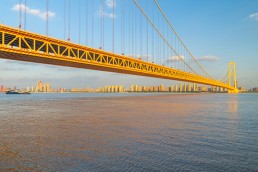© Brian NaughtonAlbert Bridge 1873
Albert Bridge 1873
Albert Bridge
An early form of cable-stayed bridge design
Key Facts
Built using the Ordish–Lefeuvre system
2-lane road bridge
An English Heritage Grade II listed structure
Location
London, England
Across the River Thames
Connects Chelsea (north bank) with Battersea (south bank)
Designers / Engineers
Rowland Mason Ordish (1873)
Sir Joseph Bazalgette (1884-87)
Greater London Council (1973)
Description
Rigid suspension bridge
122m main span
216m total length
Main contractors
Albert Bridge Company
Construction
Began in 1870
Opened 23 August 1873
The Bridge
Designed and built by Rowland Ordish as a cable-stayed bridge, it proved to be structurally unsound. Sir Joseph Bazalgette incorporated some of the design elements of a suspension bridge in 1887 and in 1973 the GLC added two concrete piers, transforming the central span into a simple beam bridge. As a result the Albert Bridge is an unusual hybrid of three different design styles.
The bridge acquired the nickname of “The Trembling Lady” because of its tendency to vibrate, particularly when used by troops from the nearby Chelsea Barracks. Concerns about the risks of mechanical resonance led to notices being placed at the entrances warning troops to break step when crossing the bridge.































































